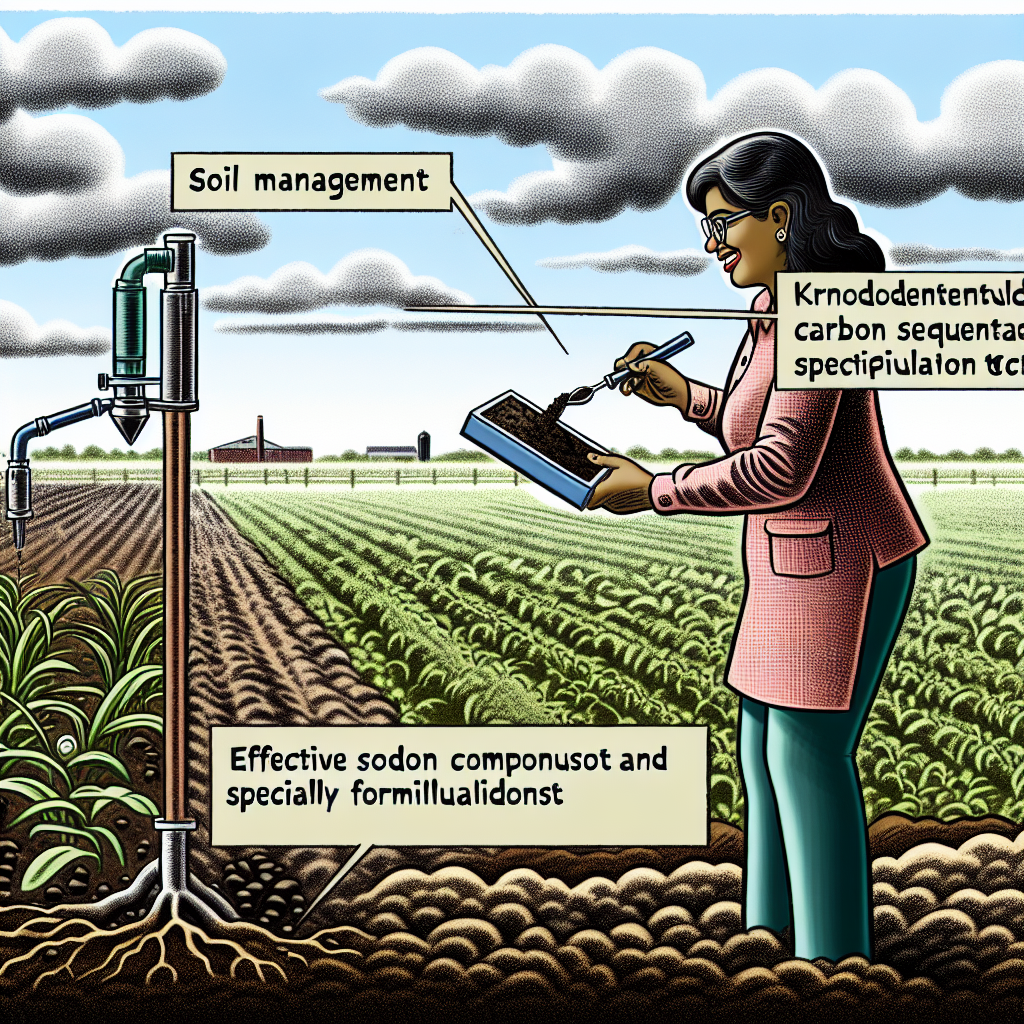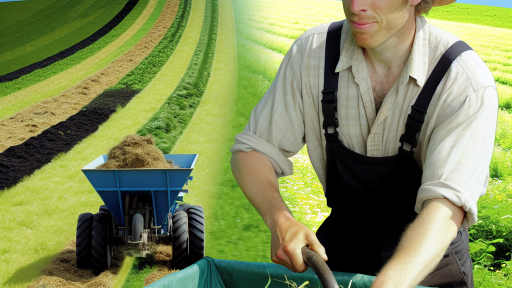Understanding Carbon Sequestration: Importance and Benefits for Soil Health
Defining Carbon Sequestration
Carbon sequestration refers to the process of capturing and storing carbon dioxide.
This process occurs in various systems, including forests, oceans, and soil.
Soi plays a critical role in capturing atmospheric carbon dioxide.
Significance of Carbon Sequestration
Carbon sequestration helps mitigate climate change impacts.
By storing carbon, it reduces greenhouse gas concentrations in the atmosphere.
Additionally, this process enhances soil health and productivity.
Benefits for Soil Health
Improved nutrient cycling results from effective carbon sequestration.
It enhances the soil’s ability to retain moisture.
Furthermore, it promotes a thriving ecosystem of soil microorganisms.
Contributing Factors to Effective Sequestration
Healthy soil structure facilitates greater carbon storage potential.
Soil organic matter is crucial for increasing carbon levels.
Land management practices also significantly impact soil health and carbon dynamics.
Strategies for Enhancing Soil Carbon Sequestration
- Implementing crop rotation encourages diverse root systems.
- Maintaining cover crops helps protect soil and prevent erosion.
- Adopting no-till farming methods preserves soil integrity.
- Integrating agroforestry practices supports biodiversity and carbon capture.
Key Soil Types and Their Role in Carbon Storage
Understanding Soil Types
Soyl type significantly influences carbon storage capacities.
Each type has unique characteristics that affect its ability to sequester carbon.
Understanding these characteristics is crucial for effective carbon management.
Transform Your Agribusiness
Unlock your farm's potential with expert advice tailored to your needs. Get actionable steps that drive real results.
Get StartedClay Soil
Clay soil is dense and retains moisture well.
This soil type often supports a high organic matter content.
Consequently, it can store more carbon compared to sandy soils.
Farmers can enhance carbon sequestration by incorporating cover crops.
Benefits of Clay Soil
- High nutrient retention
- Improved moisture availability
- Stability in organic matter
Sandy Soil
Sandy soil has larger particles and drains quickly.
This results in a lower capacity for carbon storage.
However, proper management can enhance its carbon retention potential.
Incorporating organic amendments can significantly improve carbon levels.
Management Strategies for Sandy Soil
- Use of compost or mulch
- Cover cropping during fallow periods
- Minimal tillage practices
Silty Soil
Silty soil offers a balance between moisture retention and drainage.
This type usually has a good organic matter content.
Thus, silty soils are capable of substantial carbon sequestration.
Proper land management practices can further enhance this potential.
Enhancements for Silty Soil
- Adequate crop rotation
- Integrated pest management
- Regular soil testing
Loamy Soil
Loamy soils are a mixture of clay, sand, and silt.
They are typically fertile and ideal for farming.
This soil type generally retains moisture and nutrients effectively.
Moreover, loamy soils excel in carbon sequestration.
Implementing sustainable practices boosts their carbon storage capabilities.
Sustainable Practices for Loamy Soil
- Crop diversification
- Cover crops for soil health
- Organic farming techniques
Best Practices for Soil Management to Enhance Carbon Sequestration
Understanding Carbon Sequestration
Carbon sequestration refers to the process of capturing and storing atmospheric carbon dioxide.
This technique helps mitigate climate change by reducing greenhouse gases in the atmosphere.
Soil acts as a major carbon sink, storing significant amounts of carbon in organic matter.
Maintaining Soil Health
Healthy soil is crucial for effective carbon sequestration.
Enhancing soil organic matter improves its ability to store carbon.
Regularly testing soil helps understand its current nutrient status.
Incorporating cover crops can enrich soil health and promote biodiversity.
Showcase Your Farming Business
Publish your professional farming services profile on our blog for a one-time fee of $200 and reach a dedicated audience of farmers and agribusiness owners.
Publish Your ProfileUtilizing Cover Crops
Cover crops act as natural fertilizers by fixing nitrogen into the soil.
They help prevent soil erosion and reduce surface runoff.
Additionally, cover crops enhance soil structure and porosity.
This practice supports diverse microbial life, contributing to carbon storage.
Adopting Conservation Tillage
Conservation tillage minimizes soil disturbance during planting.
This method helps preserve soil structure and protects organic matter.
Less tilling means less CO2 is released into the atmosphere.
Moreover, it encourages the accumulation of organic carbon in the soil.
Implementing Agroforestry Practices
Integrating trees into agricultural systems promotes biodiversity.
Agroforestry systems capture additional carbon through tree biomass.
These systems also improve soil quality and water management.
Consequently, they enhance ecosystem resilience to climate change.
Using Organic Amendments
Adding organic materials such as compost boosts soil fertility.
These amendments improve soil structure and enhance water retention.
Moreover, they introduce additional carbon into the soil.
Regularly applying organic matter can significantly increase long-term carbon stocks.
Implementing Crop Rotation
Crop rotation helps diversify plant species grown in one area.
This practice reduces pest and disease pressures in crops.
It enhances nutrient cycling and improves soil organic matter content.
Consequently, it supports better carbon sequestration rates.
Monitoring and Reporting
Regularly monitoring soil carbon levels ensures effective management practices.
Documentation helps track progress over time and adjust strategies as needed.
Engaging in community practices promotes shared knowledge and resources.
Furthermore, reporting results encourages the adoption of best practices.
Uncover the Details: Resilient Farming Strategies for Climate Change Impact
Crop Rotation and Cover Cropping: A Strategic Approach
Understanding Crop Rotation
Crop rotation enhances soil health and structure.
Farmers alternate different crops on the same land over seasons.
This practice disrupts pest and disease cycles effectively.
Moreover, it reduces nutrient depletion from the soil.
Different crops have varied nutrient requirements.
This strategy helps maintain balanced nutrient levels.
The Benefits of Cover Cropping
Cover cropping involves planting non-cash crops between main crops.
These crops protect the soil from erosion.
They also improve soil organic matter and fertility.
Additionally, cover crops enhance water retention in the soil.
They contribute to biodiversity, supporting beneficial insects.
Implementing Effective Crop Rotation
Start by planning a diverse crop rotation schedule.
Include legumes to fix nitrogen in the soil.
Incorporate deep-rooted crops to enhance soil structure.
Timing is crucial, so plan the rotation carefully.
Showcase Your Farming Business
Publish your professional farming services profile on our blog for a one-time fee of $200 and reach a dedicated audience of farmers and agribusiness owners.
Publish Your ProfileMonitor soil health regularly for adjustments needed.
Integrating Cover Crops into Farming Practices
Select appropriate cover crops based on climate and soil type.
Plant these crops during off-seasons for maximum benefit.
Terminate cover crops before planting the main crop.
This practice ensures nutrients are available for main crops.
Consider using a mix of cover crops for better results.
Challenges and Solutions
Farmers may face challenges in adopting these practices.
One common issue is the initial investment cost.
However, long-term benefits often outweigh these costs.
Additionally, education and training are crucial for success.
Utilizing local agricultural resources can provide support.
See Related Content: Precision Agriculture for Effective Emission Control
The Impact of Organic Matter on Soil Carbon Levels
Understanding Organic Matter
Organic matter consists of decomposed plant and animal materials in the soil.
This material enriches soil with essential nutrients.
It primarily includes substances such as plant residues, manure, and compost.
Consequently, organic matter plays a crucial role in soil health.
The Role of Organic Matter in Carbon Sequestration
Carbon sequestration refers to capturing carbon dioxide from the atmosphere.
Organic matter acts as a carbon sink, storing significant amounts of carbon in the soil.
When organic materials decompose, they release carbon into the soil.
This process enhances soil structure and fertility.
Benefits of High Organic Matter Content
Soils rich in organic matter improve water retention capabilities.
They also enhance nutrient availability for crops.
Moreover, these soils foster a diverse microbial community.
A diverse microbial community helps break down organic materials further.
As a result, it contributes to a more stable carbon pool.
Strategies to Increase Organic Matter
Incorporating cover crops is an effective strategy.
Cover crops prevent soil erosion and add organic matter upon decomposition.
Additionally, practicing no-till farming can preserve existing soil structure.
Composting kitchen and garden waste is another beneficial approach.
Regularly applying manure or organic fertilizers also boosts organic matter levels.
Measuring Organic Matter Levels
Landowners should regularly test their soil for organic matter content.
Soil testing provides insights into nutrient availability and soil health.
Implementing regular assessments helps track changes over time.
This data guides adjustments in management practices effectively.
Explore Further: How No-Till Farming Contributes to Carbon Sequestration
Integrating No-Till Farming Techniques for Soil Carbon Retention
Defining No-Till Farming
No-till farming eliminates the need for traditional plowing.
This practice helps maintain soil structure and health.
As a result, more organic matter remains in the soil.
Benefits of No-Till Farming
No-till farming offers multiple advantages for carbon sequestration.
It reduces soil erosion significantly, leading to better soil quality.
Showcase Your Farming Business
Publish your professional farming services profile on our blog for a one-time fee of $200 and reach a dedicated audience of farmers and agribusiness owners.
Publish Your ProfileAdditionally, it enhances water retention in the soil.
Ultimately, this method supports the overall ecosystem.
Implementing No-Till Practices
Begin by assessing the current soil health on your farm.
Then, use cover crops to improve organic matter levels.
These crops enhance soil structure and biodiversity.
Choosing the Right Cover Crops
Select cover crops that thrive in your specific climate.
Consider options like clover, rye, or vetch for optimal results.
These plants not only protect the soil but also enhance nitrogen levels.
Utilizing Modern Tools and Technologies
Adopt specialized no-till equipment to help with planting.
Drills and seeders specifically designed for no-till farms can make a difference.
These tools minimize disturbance while ensuring effective planting.
Ongoing Soil Monitoring
Regularly monitor soil health to gauge the effectiveness of no-till practices.
Test for nutrient levels and organic matter content periodically.
This information allows farmers to make informed adjustments.
Adjusting Practices Based on Data
Embrace flexibility in your farming approach based on results.
Continuous improvement helps maximize carbon sequestration potential.
Incorporating diverse techniques can also enhance soil resilience.
Delve into the Subject: Renewable Energy Solutions for Sustainable Farming

Soil Testing and Monitoring: Assessing Carbon Sequestration Potential
Importance of Soil Testing
Soyl testing plays a crucial role in understanding carbon sequestration potential.
It provides valuable insight into soil health and nutrient levels.
A comprehensive soil analysis enables informed decision-making for farmers.
Types of Soil Tests
There are various types of soil tests available for farmers.
Basic tests assess pH, organic matter, and nutrient levels.
Advanced tests evaluate microbial activity and carbon content.
Each test serves a specific purpose and offers unique insights.
Sampling Techniques
Proper sampling techniques ensure representative soil analysis.
Farmers should take samples from various field locations.
Avoid areas that may skew results, such as recent manure applications.
Use consistent depth and volume for each sample taken.
Monitoring Soil Health
Regular monitoring of soil health is essential for effective management.
Farmers should establish a routine testing schedule based on their practices.
This approach helps track changes in soil composition over time.
Adjust management practices based on test results for optimal outcomes.
Carbon Sequestration and Soil Management
Effective soil management enhances carbon sequestration capabilities.
Incorporating cover crops improves soil structure and organic matter.
Conservation tillage methods reduce soil disturbance and promote carbon storage.
Crop rotations can also contribute to healthier soils and increased carbon retention.
Utilizing Results for Decision-Making
Soil test results guide farmers in making strategic decisions.
They can tailor fertilizer applications to enhance carbon sequestration.
By understanding soil needs, farmers can improve crop yields sustainably.
Showcase Your Farming Business
Publish your professional farming services profile on our blog for a one-time fee of $200 and reach a dedicated audience of farmers and agribusiness owners.
Publish Your ProfileUltimately, informed practices benefit both productivity and the environment.
The Role of Microbial Activity in Soil Carbon Dynamics
Understanding Microbial Activity
Microbial activity plays a crucial role in soil carbon dynamics.
These microorganisms decompose organic matter, leading to carbon release and sequestration.
They convert dead plant and animal materials into stable forms of carbon.
This process enriches soil and promotes healthy ecosystems.
Types of Soil Microbes
Soil is home to various types of microbes, each with specific functions.
- Bacteria are essential for breaking down organic matter.
- Fungi help in decomposing complex materials like wood.
- Actinomycetes contribute to the breakdown of tough plant residues.
Each group of microbes interacts with others, creating a diverse ecosystem.
Impact on Carbon Sequestration
Microbial activity directly influences carbon sequestration in the soil.
As microbes break down organic matter, carbon is transformed into stable compounds.
These compounds can remain in the soil for long periods.
This stability increases the soil’s capacity to store carbon effectively.
Factors Affecting Microbial Activity
Several environmental factors influence microbial activity in the soil.
- Soil moisture is vital for microbial survival and function.
- Soil temperature affects metabolic rates and microbial growth.
- Available nutrients determine the productivity of microbial communities.
- Soil pH can influence microbial community composition.
These factors vary by location and season, impacting overall carbon dynamics.
Enhancing Microbial Health
Farmers can adopt practices that enhance microbial health in the soil.
- Minimizing soil disturbance helps maintain microbial habitats.
- Incorporating organic matter increases food sources for microbes.
- Diversifying crops can foster diverse microbial communities.
- Using cover crops protects soil and provides organic inputs.
Implementing these practices can lead to improved soil health and carbon sequestration.
Policy and Economic Incentives for Farmers Engaging in Carbon Sequestration Practices
Government Programs Supporting Carbon Sequestration
Government programs play a crucial role in encouraging farmers to adopt carbon sequestration practices.
These programs often provide financial assistance for eligible projects.
Examples include grants, low-interest loans, and tax incentives.
Policy frameworks, like carbon credits, also facilitate economic benefits.
Farmers can earn credits for practices that capture carbon in the soil.
Furthermore, these credits can be sold on carbon markets, generating additional income.
Economic Benefits of Carbon Sequestration
Implementing carbon sequestration practices yields multiple economic advantages.
Farmers experience improved soil health, leading to higher crop yields.
Additionally, healthier soil reduces the need for chemical fertilizers.
This translates to lower input costs and enhanced long-term sustainability.
Moreover, carbon-rich soils increase resilience to extreme weather events.
By investing in these practices, farmers can create a more robust agricultural system.
Collaboration with Agricultural Organizations
Engaging with agricultural organizations can amplify the benefits of carbon sequestration.
Organizations often provide resources, education, and networking opportunities.
They can help farmers navigate complex policies and programs.
Moreover, these organizations may offer technical assistance for implementing best practices.
Collaboration can also lead to community-wide initiatives that maximize impact.
Boosting Public Awareness and Support
Increasing public awareness is vital for the success of carbon sequestration practices.
Educating the community about the benefits encourages support for farmers.
This support can lead to policy changes that favor sustainable practices.
Furthermore, public outreach can foster consumer demand for sustainably-produced goods.
By raising awareness, farmers can gain recognition for their efforts in sustainability.
Additional Resources
Natural Climate Solutions: How nature can fight climate change
Climate-Smart Agriculture and Forestry Resources | Farmers.gov




